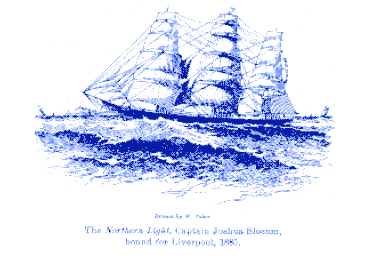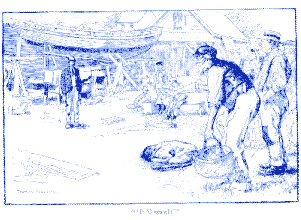Excerpt from
Sailing Alone Around the World
by Joshua Slocum
edited by Brian Anderson
(click HERE
for the entire text)
In Boston during the winter of 1892, Captain
Joshua Slocum was 51 and had commanded and been part owner of
a number of ships, but chance and innovation had washed him
ashore and left him broke. One day (I always picture it in a
low-ceilinged bar, filled with tobacco smoke, the smell of a
working harbor, and sailors cast upon the shore as steamships
belching black clouds of smoke took over the seas) a whaling
captain offers him a ship, but one that “wants some repairs.”

“I was only too glad to accept,” Slocum
wrote, “for I had already found that I could not
obtain work in the shipyard without first paying fifty dollars
to a society, and as for a ship to command--there were not enough
ships to go round. Nearly all our tall vessels had been cut
down for coal-barges, and were being ignominiously towed by
the nose from port to port, while many worthy captains addressed
themselves to Sailors' Snug Harbor.
Reading between the lines, it was a cruel
joke, but one that Slocum shrugged off, building another “Spray”
essentially from scratch. After sailing his 37-foot oyster sloop
around the world, and writing a bestseller about his adventures,
he no doubt enjoyed his oysters, beer and the last laugh, served
cold upon his return to Boston six years later.
The next day I landed at Fairhaven, opposite New
Bedford, and found that my friend had something of a joke on
me. For seven years the joke had been on him. The "ship"
proved to be a very antiquated sloop called the Spray, which
the neighbors declared had been built in the year 1. She was
affectionately propped up in a field, some distance from salt
water, and was covered with canvas. The people of Fairhaven,
I hardly need say, are thrifty and observant. For seven years
they had asked, "I wonder what Captain Eben Pierce is going
to do with the old Spray?" The day I appeared there was
a buzz at the gossip exchange: at last some one had come and
was actually at work on the old Spray. "Breaking her up,
I s'pose?" "No; going to rebuild her." Great
was the amazement. "Will it pay?" was the question
which for a year or more I answered by declaring that I would
make it pay.
My ax felled a stout oak-tree near by for a keel,
and Farmer Howard, for a small sum of money, hauled in this
and enough timbers for the frame of the new vessel. I rigged
a steam-box and a pot for a boiler. The timbers for ribs, being
straight saplings, were dressed and steamed till supple, and
then bent over a log, where they were secured till set. Something
tangible appeared every day to show for my labor, and the neighbors
made the work sociable. It was a great day in the Spray shipyard
when her new stem was set up and fastened to the new keel. Whaling-captains
came from far to survey it. With one voice they pronounced it
"A 1," and in their opinion "fit to smash ice."
The oldest captain shook my hand warmly when the breast-hooks
were put in, declaring that he could see no reason why the Spray
should not "cut in bow-head" yet off the coast of
Greenland. The much-esteemed stem-piece was from the butt of
the smartest kind of a pasture oak. It afterward split a coral
patch in two at the Keeling Islands, and did not receive a blemish.
Better timber for a ship than pasture white oak never grew.
The breast-hooks, as well as all the ribs, were of this wood,
and were steamed and bent into shape as required. It was hard
upon March when I began work in earnest; the weather was cold;
still, there were plenty of inspectors to back me with advice.
When a whaling-captain hove in sight I just rested on my adz
awhile and "gammed" with him.
 New
Bedford, the home of whaling-captains, is connected with Fairhaven
by a bridge, and the walking is good. They never "worked
along up" to the shipyard too often for me. It was the
charming tales about arctic whaling that inspired me to put
a double set of breast-hooks in the Spray, that she might shunt
ice.
New
Bedford, the home of whaling-captains, is connected with Fairhaven
by a bridge, and the walking is good. They never "worked
along up" to the shipyard too often for me. It was the
charming tales about arctic whaling that inspired me to put
a double set of breast-hooks in the Spray, that she might shunt
ice.
The seasons came quickly while I worked. Hardly
were the ribs of the sloop up before apple-trees were in bloom.
Then the daisies and the cherries came soon after. Close by
the place where the old Spray had now dissolved rested the ashes
of John Cook, a revered Pilgrim father. So the new Spray rose
from hallowed ground. From the deck of the new craft I could
put out my hand and pick cherries that grew over the little
grave. The planks for the new vessel, which I soon came to put
on, were of Georgia pine an inch and a half thick. The operation
of putting them on was tedious, but, when on, the calking was
easy. The outward edges stood slightly open to receive the calking,
but the inner edges were so close that I could not see daylight
between them. All the butts were fastened by through bolts,
with screw-nuts tightening them to the timbers, so that there
would be no complaint from them. Many bolts with screw-nuts
were used in other parts of the construction, in all about a
thousand. It was my purpose to make my vessel stout and strong.
Now, it is a law in Lloyd's that the Jane repaired
all out of the old until she is entirely new is still the Jane.
The Spray changed her being so gradually that it was hard to
say at what point the old died or the new took birth, and it
was no matter. The bulwarks I built up of white-oak stanchions
fourteen inches high, and covered with seven-eighth-inch white
pine. These stanchions, mortised through a two-inch covering-board,
I calked with thin cedar wedges. They have remained perfectly
tight ever since. The deck I made of one-and-a-half-inch by
three-inch white pine spiked to beams, six by six inches, of
yellow or Georgia pine, placed three feet apart. The deck-inclosures
were one over the aperture of the main hatch, six feet by six,
for a cooking-galley, and a trunk farther aft, about ten feet
by twelve, for a cabin. Both of these rose about three feet
above the deck, and were sunk sufficiently into the hold to
afford head-room. In the spaces along the sides of the cabin,
under the deck, I arranged a berth to sleep in, and shelves
for small storage, not forgetting a place for the medicine-chest.
In the midship hold, that is, the space between cabin and galley,
under the deck, was room for provision of water, salt beef,
etc., ample for many months.

The hull of my vessel being now put together as
strongly as wood and iron could make her, and the various rooms
partitioned off, I set about "calking ship." Grave
fears were entertained by some that at this point I should fail.
I myself gave some thought to the advisability of a "professional
calker." The very first blow I struck on the cotton with
the calking-iron, which I thought was right, many others thought
wrong. "It'll crawl!" cried a man from Marion, passing
with a basket of clams on his back. "It'll crawl!"
cried another from West Island, when he saw me driving cotton
into the seams. Bruno simply wagged his tail. Even Mr. Ben J----,
a noted authority on whaling-ships, whose mind, however, was
said to totter, asked rather confidently if I did not think
"it would crawl." "How fast will it crawl?"
cried my old captain friend, who had been towed by many a lively
sperm-whale. "Tell us how fast," cried he, "that
we may get into port in time." However, I drove a thread
of oakum on top of the cotton, as from the first I had intended
to do. And Bruno again wagged his tail. The cotton never "crawled."
When the calking was finished, two coats of copper paint were
slapped on the bottom, two of white lead on the topsides and
bulwarks. The rudder was then shipped and painted, and on the
following day the Spray was launched. As she rode at
her ancient, rust-eaten anchor, she sat on the water like a
swan.
The Spray's dimensions were, when finished,
thirty-six feet nine inches long, over all, fourteen feet two
inches wide, and four feet two inches deep in the hold, her
tonnage being nine tons net and twelve and seventy-one hundredths
tons gross.
Then the mast, a smart New Hampshire spruce, was
fitted, and likewise all the small appurtenances necessary for
a short cruise. Sails were bent, and away she flew with my friend
Captain Pierce and me, across Buzzard's Bay on a trial-trip--all
right. The only thing that now worried my friends along the
beach was, "Will she pay?" The cost of my new vessel
was $553.62 for materials, and thirteen months of my own labor.
I was several months more than that at Fairhaven, for I got
work now and then on an occasional whale-ship fitting farther
down the harbor, and that kept me the overtime.”

